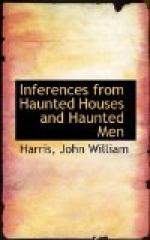Miss Campbell got a word, imperfect perhaps, but a better-developed effort developed better results. It is worth remarking that in another experimental transfer of thought, where the percipient was not warned, when Mr. Godfrey’s apparition was seen by a lady friend, she heard a curious sound like birds in the ivy. It is by no means unlikely that this was the result of his first trying to attract her attention.[7]
[Footnote 7: Podmore’s “Studies,” p. 250.]
The eye impression moving to the ear in a new and strange way, there is perhaps a stirring and dragging of the cartilages.
That Mr. Godfrey’s friend appeared in response and spoke to him, and referred back to some joint conversation, is curious.
It must be said here that the speech coming from within is extremely indicative of a real transferred or hypnotic speech, and its coming from within facilitates surprise where it is used fraudulently or criminally. A certain amount of collateral trickery would enhance this. It is easily confounded with the victim’s own thoughts.
The appearance of a person to another does not seem to be as difficult as the causing another person to appear to a third person. In this case the second person should apparently be hypnotised, and willed to appear to the third. The third person must know the second person.[8]
[Footnote 8: Osgood Mason, “Telepathy,” &c., chap. x.]
The apparition to Miss Ducane is interesting, and it is a pity it could not be recognised.[9] It was seen in the mirror by her sisters, with one exception; but she (Miss Ducane) and the other young ladies all felt the cold air.
[Footnote 9: Podmore’s “Studies,” p. 275.]
Miss Freer, who saw the shadows of a figure on the wall first, and then the figure itself, must have been more scientifically operated on, but an apparition to several young ladies is harder to bring about. The original of Miss Freer’s visions should be carefully traced—the one in the drawing-room especially. How many persons would be needed to produce the rather inchoate phenomena observed by Miss Freer’s garrison is doubtful; three distinct voices, if not four, were heard,[10] and it seems probable that at least four persons would be necessary to produce very startling phenomenon—notably conversation.[11]




